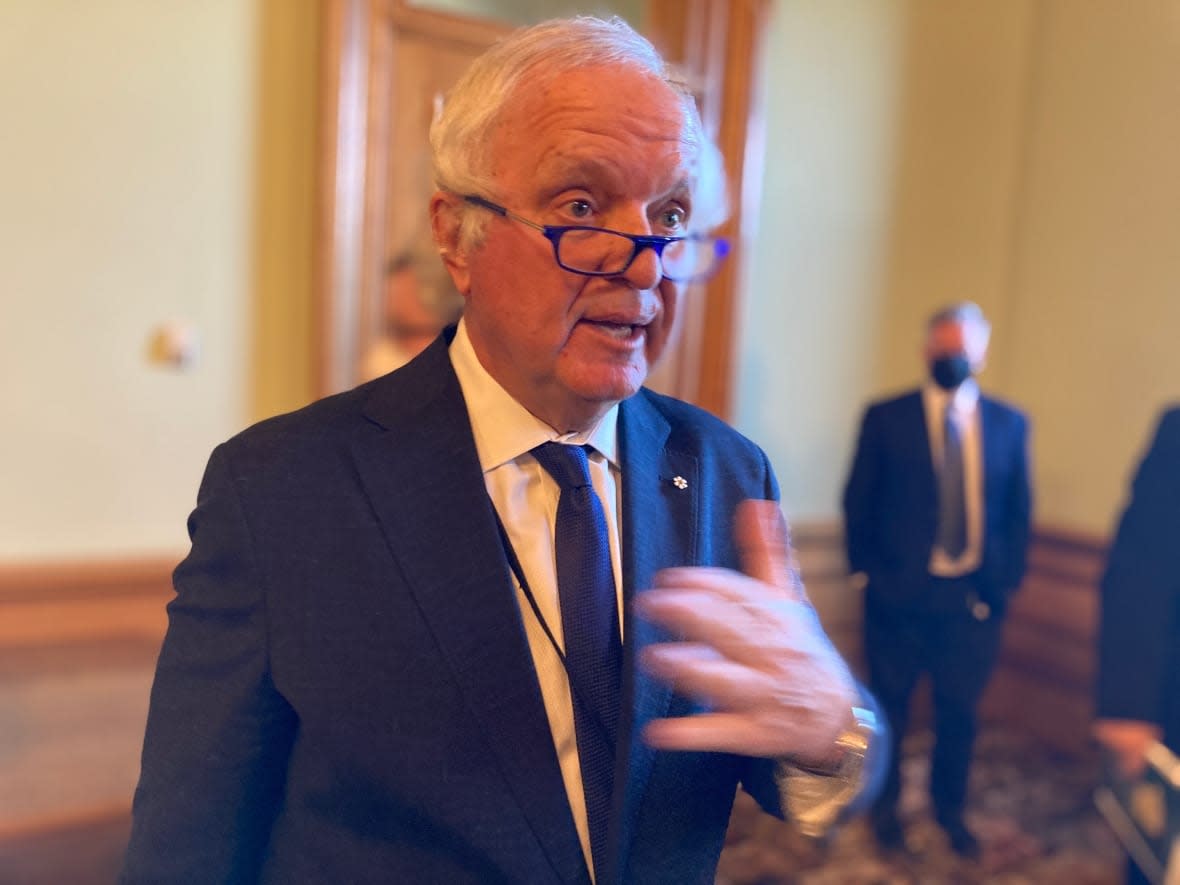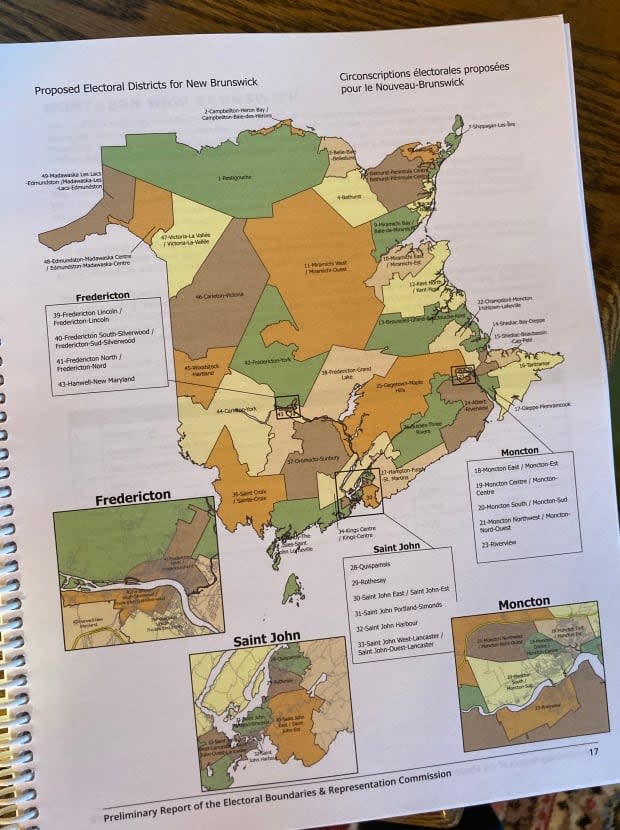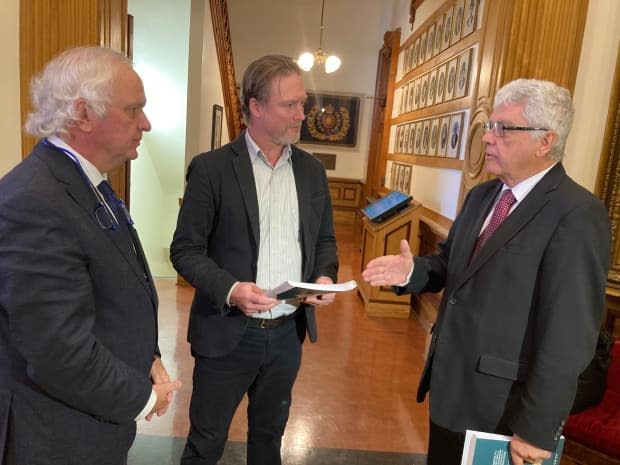No regional seat shakeup in proposed N.B. electoral map

A proposed new provincial election map for New Brunswick sticks mostly to the status quo, with few major changes and no gains or losses of seats between regions of the province.
An independent commission has mainly tweaked existing constituencies to stay within a population range required by law.
Fast-growing cities Moncton and Fredericton have not gained seats, and northern areas where the population has declined or been stagnant have not lost any.
"Although there has been a diminution of people on the north shore, it's not that significant when it comes to electors," said co-chair Roger Clinch, a former Progressive Conservative MP. "It's not significant enough to eliminate a riding there."
The map is preliminary and will be the subject of eight public consultations in January before a final version is released within 90 days.
An update to the law on riding boundaries in 2015 gave the current commission more flexibility to stretch the voting population of constituencies.

The law requires the commission to calculate the average number of voters in each riding, known as the "electoral quotient." The figure the commission used is 11,667.
"We respected the quotient and that will give us, hopefully, better representation," said co-chair Camille Thériault, a former Liberal premier.
The legislation says each riding's number of voters must be "as close as reasonably possible" to the quotient, though the commission can deviate by up to 15 per cent to accommodate what are called "communities of interest" and other factors.
The proposed map includes some northern ridings that deviate substantially from the average. Caraquet would be 14.9 per cent below the quotient, and Miramichi Bay would be 13.2 per cent below.
Meanwhile, some ridings in and around cities in the south are well over the quotient. Riverview-Albert would be 10.6 per cent above, Shediac Bay-Dieppe would be 8.1 per cent above, and Fredericton South-Silverwood would be 5.4 per cent above.
"We didn't design it so we'd have five seats here and five seats there," Clinch said. He said when the commission did the math, "it came out that way, that there were no changes in particular regions."

Clinch and Thériault refused to be drawn into discussions of specific ridings Monday, saying they wanted New Brunswickers to digest the map first and have the chance to comment at public hearings next month.
One of the few notable changes on the map is the slicing up of the current Fredericton South riding, won in the last three elections by Green Party Leader David Coon.
The proposed new map splits the southern part of the city between two new ridings, Fredericton Lincoln and Fredericton South-Silverwood, with the major traffic artery Regent Street serving as the dividing line.
That's similar to what existed before the last redrawing of the map a decade ago.
New Liberal Leader Susan Holt, who lives in Fredericton South, said in August she would wait to see a new map before deciding where she would run in the next election.
Her home would now be in Fredericton South-Silverwood, while Coon's would be in Fredericton-Lincoln, if this preliminary map is adopted.
The commission was allowed by the law to deviate from the required range of voters by up to 25 per cent in "extraordinary circumstances," such as the need to ensure fair linguistic representation.
The commissioners opted to do that in one riding, separating the current Memramcook-Tantramar riding so that francophones in Memramcook could become part of a new majority francophone Dieppe-Memramcook riding.
That leaves Tantramar with a voting population 22.4 per cent lower that the average.
The last redrawing, which created Memramcook-Tantramar, prompted complaints from francophones in the new riding that they were losing their majority-francophone constituency.
At the time, the law allowed only a five-per-cent deviation from the average, so the new commission had more leeway this year to put the village in a mostly francophone riding.
'It's been a long run'
The Acadian Society of New Brunswick filed a charter challenge against a Memramcook and Tantramar riding, and ended up settling out of court. Part of the settlement allowed for the 25 per cent "extraordinary circumstances" range.
Alexandre Cédric Doucet, president of the Acadian society, said it's taken 10 years for the change to come into effect.
"It's been a long run," he said.
"When you're a minority like Acadian francophones, good news is not high on the priority," he said. "We are very happy."
Doucet said in a presentation to the commission that the society advocated for the new riding of Dieppe-Memramcook, the integration of Néguac into the new riding of Tracadie-Néguac and to transfer Baie-Sainte-Anne to Kent-Nord. The commission delivered all of the above.
He said his group will continue to advocate for these recommendations until they're set in stone.
"We'll make some representation in that area to make sure that the recommendation will be in the final report," he said.

Maxime Bourgeois, mayor of Memramcook, said his community has been lucky in the last 10 years to have MLAs that care about the francophone issues.
However, there was always a risk of a unilingual anglophone person being elected to represent his community. He said that risk is minimized now.
He said in the last 10 years his village has worked alongside other municipalities, such as in the ridings of Sackville and Dorchester, to present a common front on provincial issues.
"Needless to say that those meetings were always held in English," he said.
Provincial law requires that an independent commission be appointed every 10 years to redraw the 49 electoral districts in the province to reflect changing population numbers.
The commissioners do not have the power to change the number of ridings.
The new map will take effect for the provincial election scheduled for Oct. 21, 2024.
The old map remains in effect for any by-elections held before then. Three ridings are now vacant: Dieppe, Restigouche-Chaleur and Bathurst East-Nepisiguit-St. Isidore, where Holt plans to run in a by-election.


